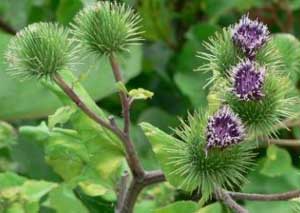Burdock
Contents
Description
Burdock is a stout plant with large pale green leaves. The stem can reach 3-4' tall, and it's enclosed with long stiff scales with hooked tips. Burdock is capped with rounded purple flowers. Appearances of this plant are known to vary upon location. Other names commonly used are lappa, beggars buttons, fox's clote, thorny burr and cocle buttons.
Habitat
Burdock can be found as hedges and in ditches in Europe, parts of Asia and North America. It is also cultivated in Japan.
Parts Used
The parts generally used are roots, rhizome/herb, and seed. Roots and rhizome are best harvested in Spetember or October.
Constituents
Inulin (found in the roots), lignans (arctigenin, matairesinol), bitters and tannic acid.
Actions
Burdock is an alterative (cleanser, aids in removal of waste products), diuretic (increases secretion and flow of urine), and bitter (stimulates secretions of digestive, encourages appetite).
Medicinal Uses
Burdock is known to be an excellent blood purifier. It's very valuable as a remedy for skin conditions which result in dry/scaly skin. If used for an extended period of time, Burdock is effective for psoriasis and associated rheumatic complaints.
Part of the action of Burdock is stimulation of digestive juices, especially bile secretion, therefore aiding in both digestion and appetite. It has been used in the treatment of anoxeria nervosa and similar conditions, also as an aid to kidney function and the healing of cystitis.
Generally, Burdock will move the body to a state of integration and health by removing such indicators as dandruff and other skin problems. Externally, it may be used as a compress or poultice to speed up the healing of ulcers and wounds. Eczema and psoriasis can also be helped this way externally, but such problems can only be completely healed from within, using internal remedies.
As a general alterative, Burdock influences the skin, kidneys, mucous and serous membranes to remove waste products. It is specific for eruptions on the head, face and neck, also for acute irritable and inflamed conditions.
Burdock may be effective for eczema, psoriasis, dermatitis, styes, sores, boils, carbuncles, rheumatism, gout, sciatica and cough. When combined with the herbs yellow dock and red clover, it is especially helpful for skin problems.
Preparation & Dose
Decoction: put 1 teaspoon of the root into a cup of water, bring to a boil and simmer 10-15 minutes. Drink this three times per day. Tincture can be give 3x's a day in the amount of 2-4ml.
Side-Effects & Interactions
Caution should be used for those with diabetes or hypoglycemia, as Burdock may cause either increases or reductions in blood sugar. Being a diuretic, it shouldn't be taken by women who are pregnant or lactating.
Allergic reaction may result in those with allergies to plants in the Asteraceae family such as ragweed, chrysanthemums, marigolds, daisies, etc. Burdock may interact with hypoglycemic drugs, anti-inflammatory medications or lithium therapy.
